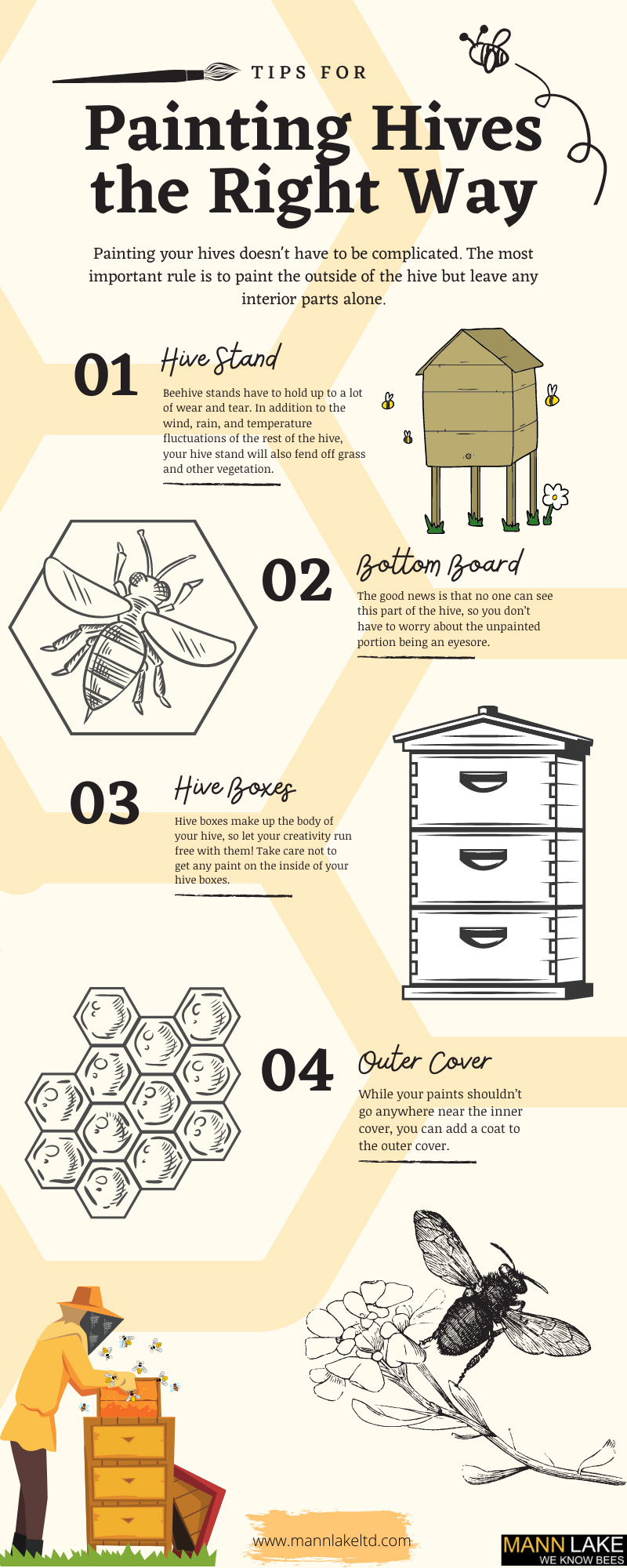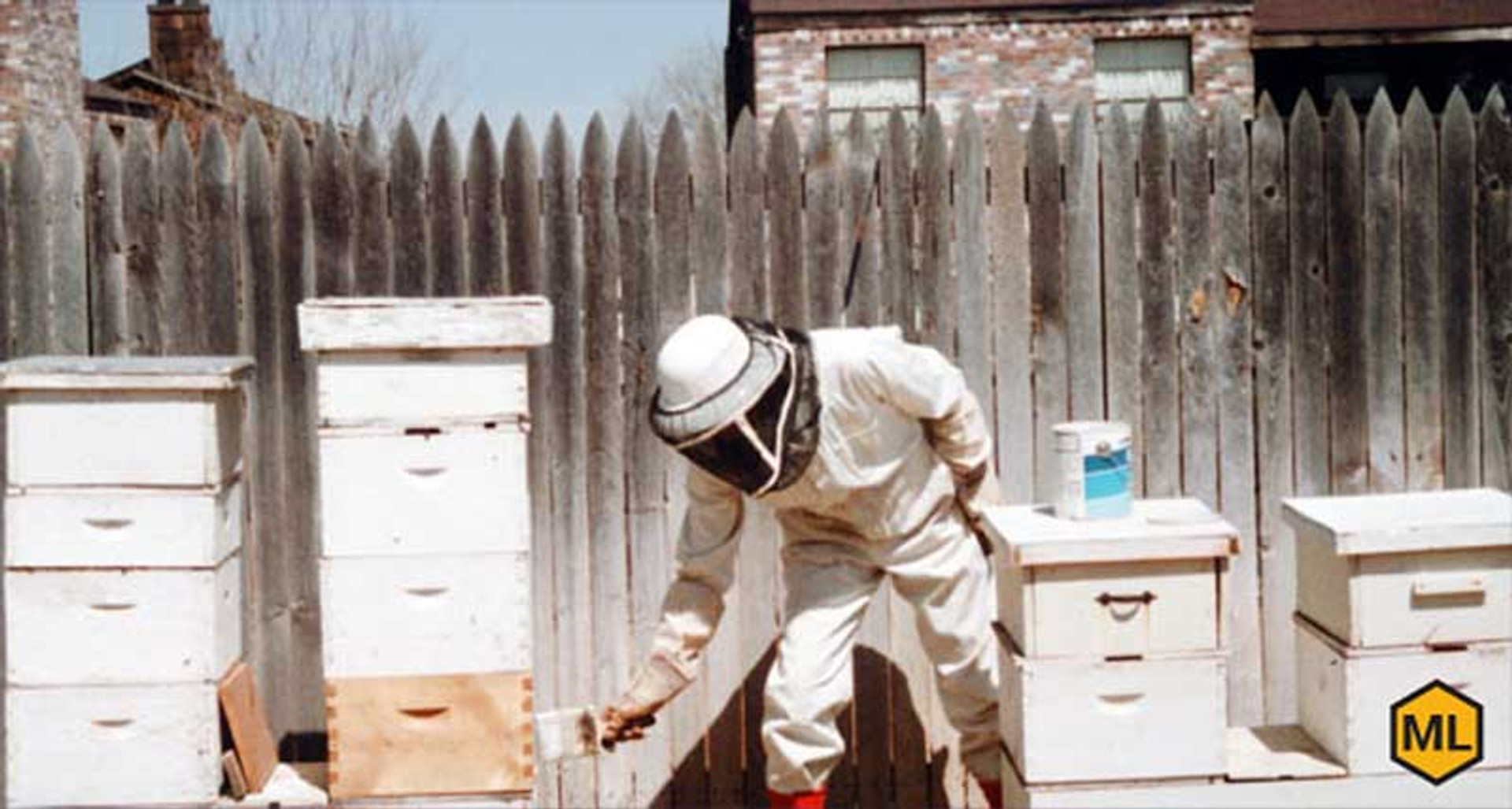Tips For Painting Hives The Right Way
Is painting on your beekeeping to-do list? While painting your hives isn’t essential, it’s still a worthwhile project that can benefit the look, feel, and functionality of your apiary. After all, your honey bees also deserve a beautiful, comfortable home to live in.
However, painting your beehives isn’t as simple as picking a pretty color and going to town with your paintbrush or paint roller. You need to know a few tricks and tips before you give your apiary a makeover.
Learn the importance of painted beehives, how to create a beautiful and healthy home for your honey bees, and simple tips for painting hives correctly.
Why Should You Paint Beehives?
Not every beekeeper paints their hives, but the ones that do have plenty of reasons to do so.
Painted beehives tend to last longer against the elements and general wear and tear. Depending on where you live, certain paint colors will also help keep the hives at a safe and comfortable temperature. However, some beekeepers simply enjoy the sight of a colorful apiary.
Below are some of the most common reasons that beekeepers take a brush to their hives.
Temperature Regulation
The right exterior paint color can help combat extreme temperatures and keep your hive comfortable for your honey bees. Many beekeepers in warmer climates paint their hives with lighter, more reflective colors such as whites or pastels. This helps keep the hive cool during those long, sweltering summer days.
In colder climates, beekeepers might choose darker colors to absorb more of the sun’s warmth during winter. This will help keep the hive’s interior warm enough for the honey bees to survive until spring. Keep your climate and seasonal temperature averages in mind when choosing a paint color for your apiary.
Protection from the Elements
Beehives face a lot of environmental wear and tear. Sun, rain, snow, and temperature fluctuations take their toll on your apiary. Over time, exposed wood can rot, warp, crack, and suffer other damage that makes your beehives unsafe, unhealthy, and structurally unstable. That kind of damage isn’t safe for your honey bees.
A layer of outdoor paint can protect the wood of your hives and help them last longer. You can also use an oil-based exterior primer for extra protection from the elements. This will stick better to your wood and make your exterior paint job stay beautiful and functional for longer.
Apiary Camouflage
Depending on where you live, your apiary might attract a lot of unwanted attention. Nosy neighbors or reckless kids are more likely to take issue with your hive if it’s standing out in the open. The more obvious your apiary is, the more likely you are to deal with complaints, vandals, and other headaches.
A clever coat of exterior latex paint can help your honey bees blend with the surrounding environment. One option is to paint your hives the same color as your house, shed, or other nearby structures. This will help the hives blend with other features of your yard, making them less obvious to general passersby.
You might also choose natural colors to help your hives blend with the trees or bushes in your yard. When your hives are no longer a focal point, they won’t attract as much unwanted attention from outsiders.
Fun
Sometimes, beekeepers paint their hives for one simple reason: it’s fun. The right latex paint color or design can turn a boring, regular beehive into a cute yard decoration. The opportunity increases tenfold when you have multiple beehives to work with.
While white is a traditional beehive color, especially in the United States, you can use whatever colors and designs your heart desires. Pastel hives are popular for the fresh, springtime feeling they bring to a yard.
Some beekeepers put their art skills to good use and decorate their hives with flowers, landscapes, and other gorgeous designs. Once you start getting creative with your hives, the possibilities are endless. You might color code different sizes of supers to tell them apart. Alternatively, you can coordinate your paints to match the rest of your yard’s décor and color scheme.
How to Paint Beehives the Right Way
Painting your hives doesn’t have to be complicated. The most important rule is to paint the outside of the hive but leave any interior parts alone. The exterior portions of your hive need extra protection from the elements, but any paint on the inside can affect your honey bees and the honey they make.
Another major tip is to start your painting process with a well-assembled hive. Make sure everything is sturdy and in place before you dig out your paints. Even the best paint job won’t last long if the hive itself falls apart quickly.
When you paint your hives, only use low-VOC paints. It’s healthier for the honey bees flying in and out of the hives and better for the environment. Similarly, give your freshly painted hives plenty of time to dry and air out before placing honey bees in them.
When painting each part of the hive, your biggest goal is to protect the exterior while keeping the interior clean and natural. There are a few hive parts you should never take a paintbrush to. These include the entrance reducer, screened portions of your bottom board, frames, and an inner cover. Below are more tips for painting the other sections of your beehive.
Hive Stand
The hive stand never houses your honey bees, so you’re free to let loose with your artistic endeavors. This is possibly the most important section of the hive to paint. Beehive stands have to hold up to a lot of wear and tear.
In addition to the wind, rain, and temperature fluctuations of the rest of the hive, your hive stand will also fend off grass and other vegetation. You also need the hive stand to hold up against mud and snow accumulating on the ground throughout the year.
Bottom Board
You can paint all wood surfaces on your bottom board with water-based paint. However, as mentioned above, don’t paint the screen if your bottom board has one. Honey bees will crawl over the screen and expose themselves to the paint. The good news is that no one can see this part of the hive, so you don’t have to worry about the unpainted portion being an eyesore.
Hive Boxes
Hive boxes make up the body of your hive, so let your creativity run free with them! Take care not to get any paint on the inside of your hive boxes.
Some people paint the top and bottom edges of hive boxes, while others feel this makes the boxes stick together in warm weather. Whether you paint the edges is up to you. The exterior is the most important part to help your hive withstand the elements.
Outer Cover
While your paints shouldn’t go anywhere near the inner cover, you can add a coat to the outer shell. However, you should avoid the inside and underside of the cover; steer clear of the metal top as well. Keep your paints on the exterior surfaces and the top and bottom edges of the cover.
Beehive Paint Ideas You Can Try
Once you’ve found the best paint for bee hives, it’s time to put your creativity to the test! Give these design ideas a try on your apiary:
- Abstract. Apply artistic strokes to add color and vibrance to your beehive. To make your creation more pleasing to the eyes, consult the color wheel for complementary color combinations. The wrong color combos can clash and make your apiary more of an eyesore than a masterpiece.
- Mural. If you’ve got the skill, flaunt it with a gorgeous mural. From painting landscapes to graffiti, the sky’s the limit when painting your hives. To help your artwork last longer, don’t forget to apply a layer of polyurethane sealant to your canvas.
- Patterns. You can still beautify your beehives, even with simple patterns. A pro tip is to use stencils to make the job easier and faster. Whether that’s a simple polka dot pattern or a scallop outline, it’s your call!
- Graphic. Even if you don’t have the best illustrating skills, you can still get away with painting your beehives using graphic-style painting. Use informal shapes, dramatic curves, and contrasting colors to nail this look.
- Architectural. Take your paint job further by adding architectural elements to your hives. A great idea is to create a mini home for your beehive that looks like an actual house or building! A word to the wise, though: keep your materials light to avoid any untoward accidents that may compromise your hive.
Painting beehives is a great way to add personality to your apiary and protect it simultaneously. Follow the above tips to make your beekeeping journey fun and colorful!


